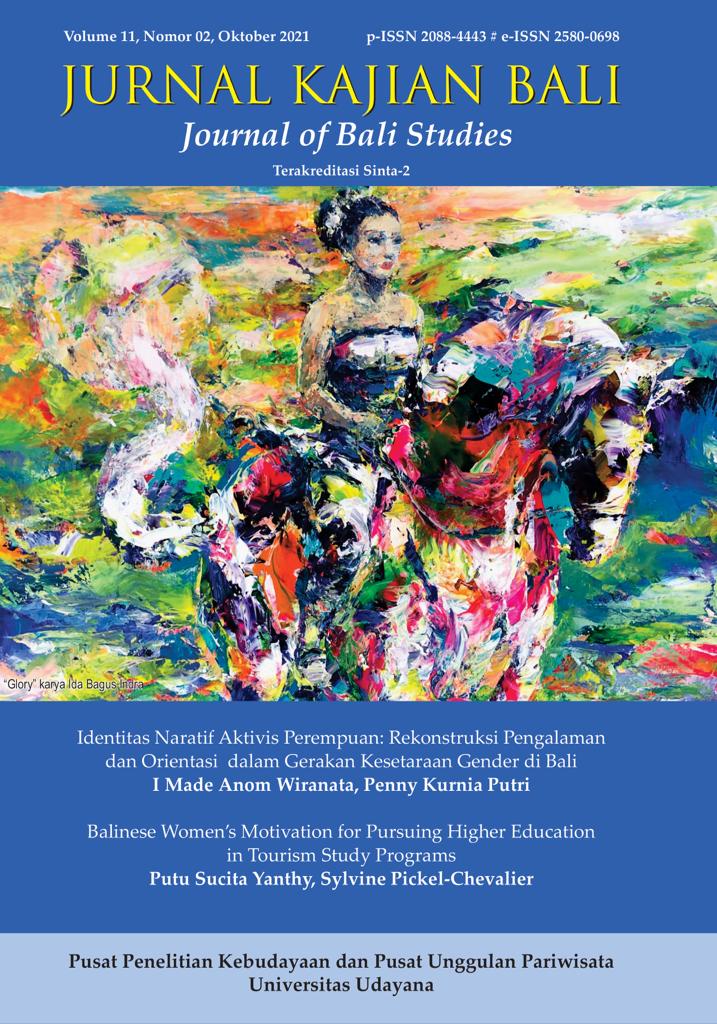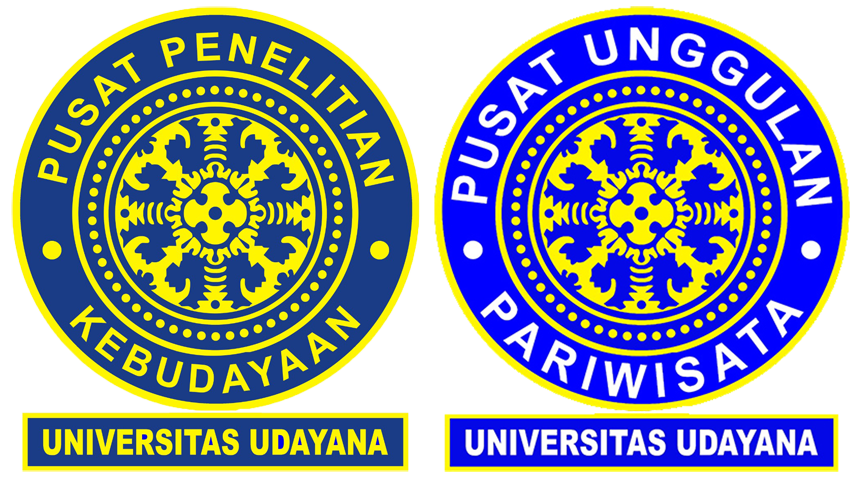Manajemen Wisata Perdesaan Berdasarkan Tingkat Kepuasan Pengunjung di Tiga Desa Wisata di Bali
Abstract
This research aims to analyse the level of visitor satisfaction in visiting rural tourism and management of rural tourism in Bali. Research was conducted in three rural tourism in Bali, namely Munduk, Jasri, and Pengelipuran from June to August 2019 through distributing questionnaires to 210 visitors. Data were analyzed based on quantitative approach by implementing the Importance Performance Analysis method. Results showed that the level of tourist satisfaction when visiting rural tourism in Bali was high in terms of attraction, hospitality, safety, and comfortability which indicated that performance of rural tourism has been in accordance with the expectation of tourists. However, the results showed that the level of tourist satisfaction is low in terms of cleanliness and health which indicated that the destination's performance does not match the expectations of tourists. Rural tourism management in Bali has been implemented holistically and comprehensively, however, implementation of marketing concept require some improvements.
Downloads
References
Adikampana, I., Kerti Pujani, L., & Nugroho, S. (2018). Partisipasi Masyarakat Lokal dalam Pengembangan Kawasan Pariwisata Candidasa. Jurnal Kajian Bali (Journal Of Bali Studies), 8(1), 53-70.
Balitoursclub. (2019). “Desa Munduk Singaraja”. Sumber: https://www.balitoursclub.net/
desa-munduk-singaraja/. Diakses 24/05/2021.
Cai, L. A., J. Liu, and Z. Huang. (2008). “Identifying Rural Tourism Markets: A Practical Tool”. Journal of Hospitality & Leisure Marketing, 17:3-4, 418-434.
Dinas Pariwisata Propinsi Bali (2019). “Jumlah Desa Wisata di Bali” https://disparda.baliprov.go.id/wp-content/uploads/2019/10/tabel-32.-1.pdf Diakses 09/09/2021
Fajar Bali. (2020). “Desa Pengelipuran Masih Jadi Primadona dan Daya Tarik Percontohan Destinasi Wisata”. Sumber: https://fajarbali.com/bali-timur/bangli/6817-desa-pengelipuran-masih-jadi-primadona-dan-daya-tarik-percontohan-destinasi-wisata. Diakses 24/05/2021.
Inskeep, E. (2001). Tourism Planning an Integrated and Sustainable Development Approach. March 1991. 528p. ISBN: 978-0-471-29392-7.
Kompas Travel. (2013). “Desa Pekraman Jasri Desa Wisata Terbaik 2013”. Sumber: https://travel.kompas.com/read/2013/12/05/1510470/Desa.Pekraman.Jasri.Desa.Wisata.Terbaik.2013. Diakses 24/05/2021.
Kompas Travel. (2021). “Berapa Jumlah Desa Wisata di Indonesia?” https://travel.kompas.com/read/2021/08/01/180600927/berapa-jumlah-desa-wisata-di-indonesia-?page=all Diakses 08/09/2021
Kotler, P., and H. Kertajaya. (2017). Marketing 4.0. Moving from Traditional to Digital. Published by John Wiley & Sons. Inc., New Jersey, Canada.
Kuo, Y.F., J.Y. Chen and W.J. Deng. (2012). “IPA–Kano model: A new tool for categorising and diagnosing service quality attributes”. Total Quality Management & Business Excellence, 23(7-8), 731-748.
Levenburg, N. M., & S.R. Magal. (2005). “Applying importance-performance analysis to evaluate e-business strategies among small firms”. E-service Journal, 3(3), 29-48.
Mill, R. C., and A.M. Morrison. (2009). The Tourism System. Kendall Hunt Publising Company. The United States of America.
Mjalager, A. M. (2016). “Agricultural Diversification into Tourism: Evidence of a European Community Development Programme.” Tourism Management, 7 (2): 103-11.
Oppermann, M. (2016). “Rural Tourism in Southern Germany”. Annals of Tourism Research, 23 (1): 86-102.
Peter, J.P., and J.C. Olson. (2016). Consumer Behaviour and Marketing Strategy. 5th Edition. IRWIN Publisher. 660 p.
Putra, I. N. D (ed). (2015). Pariwisata Berbasisi Masyarakat Model Bali. Program Studi Magister Pariwisata Universitas Udayana bekerjasama dengan Buku Arti. ISBN 978-602-6896-04-9.
Reisinger, Y. (2009). International Tourism: Culture and Behaviour. First Edition. Elsevier Ltd. 411p.
Runa, I W. (2012). “Pembangunan Berkelanjutan Berdasarkan Konsep Tri Hita Karana untuk Kegiatan Ekowisata”. Jurnal Kajian Bali, Volume 02 Nomor 01, April 2012: 149-162.
Simanungkalit, V., D.A. Sari, F. Teguh, H. Ristanto, I.K. Permanasari, L. Sambodo, Masyhud, S. Wahyuni, H. Hermantoro, C. Hartati dan D. Vitriani. (2015). Buku Panduuan Desa Wisata Hija. Penerbit: Asisten Deputi Urusan Ketenagalistrikan dan Aneka Usaha Kementerian Koperasi dan UMK Republik Indonesia. Jl. HR. Rasuna Sahid. Kav 3-4. Lt. 2. Kuningan. Jakarta Selatan 1290.
Suryawardani, I G.A.O., A. S. Wiranatha and P. Christine. (2014). “Destination Marketing Strategy in Bali Through Optimizing the Potential of Local Products”. E-Journal of Tourism, 3(1) March, 2014: p (35-49). P-ISSN: 2541-0857, e-ISSN: 2407-392X.
Suryawardani, I G. A. O., and A. S. Wiranatha. (2016). “Strategy prioritization for sustainable tourism in Bali, Indonesia: Focusing on local agricultural products analytical hierarchy process (AHP) approach”. The International Society for Southeast Asian Agricultural Sciences (ISSAAS), 22(1), June 2016, p: 96-110. ISSN 0859-3132.
Suryawardani, I G.A. O., A. S. Wiranatha, I K. Satriawan, I. B. G. Pujaastawa, E. N. Kencana and I W. Tika. (2021). “The Role of Branding in Increasing Revisit at Agritourism in Jatiluwih Bali”. SOCA Jurnal Sosial Ekonomi Pertanian. Mei, Vol 15 (2). P-ISSN: 1411-7177, e-ISSN 2615 6628. Publisher: Program Studi Agribisnis Fakultas Pertanian Universitas Udayana.
Sutawan, N. (1987). Farmer-managed Irrigation Systems and the Impact of Government Assistan: A Note from Bali, Indonesia. Public Intervention in Farmer-managed Irrigation Systems; page 43-71. International Irrigation Management Institute (IIMI) and Water and Energy Commission Secretariat (WECS) of the Ministry of Water Resources, Government of Nepal. 1987. Colombo, Sri Lanka. ISBN: 92-9090-101-9: IIMI pub. iv, 323 p.
Swarbrooke, J. and Susan Horner. (2009). Consumer Behaviour in Tourism. Second Edition. British Library Cataloguing in Publicing Data.
UNWTO. (2012). “Sustainable Development”. Sumber: http://sdt.unwto.org/en/ content/
about-us-5. Diakses 25/05/2021.
Wilson, S., D. R. Fesenmaier, J. Fesenmaier, and J. C. Van. (2016). “Factors for Success in Rural Tourism Development”. Journal of Travel Research. 40(20):132-138. Sage Publcation.
Wiranatha, A. S. (2015). “Sustainable Development Strategy for Ecotourism at Tangkahan, North Sumatera”. E-Journal of Tourism, Vol.2 No (2015): 1-10 http://ojs.unud.ac.id/index.php/eot, e-ISSN 2407-392X. p-ISSN: 2541-08571.
Wiranatha, A.S., and A.A.G.R. Dalem. (2010). “Implementation of local knowledge “Tri Hita Karana” on ecotourism management in Bali”. SOCA (Journal on Socio-Economics of Agricultre and Agribusines, 10(1): 94-99. Februari. 2010. ISSN: 1411-7172.
Wiranatha and Suryawardani. (2015). Authenticity: Key Success in Destination Marketing of Bali Tourism. Proceeding in Tourism Hospitality International Conference. page:1-10. Surayabaya: 19-20 October 2015. SBN: 987-983-2078-83-8.
Zhang, H. Q., & Chow, I. (2014). “Application of importance-performance model in tour guides’ performance: evidence from mainland Chinese outbound visitors in Hong Kong”. Tourism management, 25(1), 81-91.

This work is licensed under a Creative Commons Attribution 4.0 International License.



















